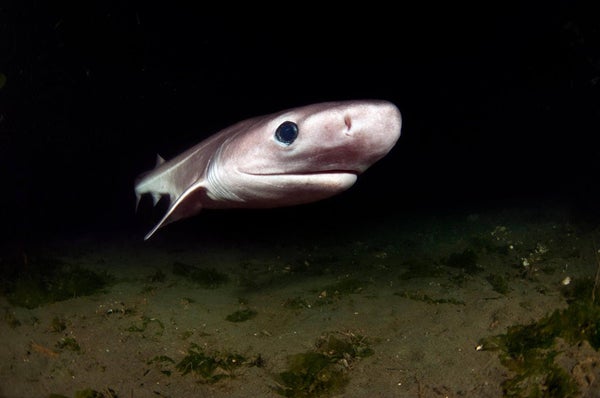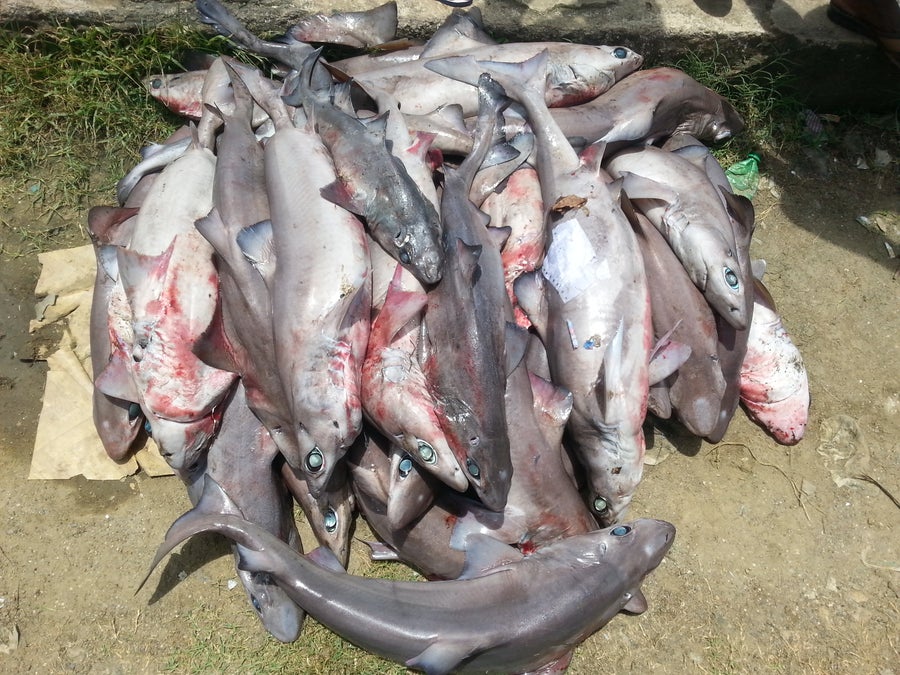Deepwater Sharks Are Threatened by Demand for Liver Oil
One in seven species of deepwater sharks and rays is threatened with extinction due to the liver oil and meat commerce and rising fishing applied sciences that make it potential to catch deep-sea fishes

A bluntnose sixgill shark (Hexanchus griseus) off Puget Sound.
The surging marketplace for shark liver oil, present in merchandise starting from dietary dietary supplements to cosmetics, is posing a significant menace to deepwater shark species—people who dwell within the inky black waters not less than 200 meters under the floor—which use variations reminiscent of bioluminescence to assist them thrive.
Shark liver oil is used as a supply of squalene, which is utilized in magnificence merchandise reminiscent of skincare gadgets as a result of it’s an emollient and antioxidant. It may be present in dietary dietary supplements, in addition to in vaccines, the place it helps stimulate the physique’s immune response.
The rising demand for liver oil (together with meat) has pushed shark fishing to the purpose the place one in every seven known shark and ray species is threatened with extinction, based on a brand new research printed on Thursday in Science. That’s a specific concern with regards to species that frequent the depths as a result of “about half of all sharks are thought-about deepwater species, and we’re nonetheless discovering new species of deepwater sharks on a regular basis as we discover extra of the deep ocean,” says the research’s lead creator Brit Finucci, a fisheries scientist at New Zealand’s Nationwide Institute of Water and Atmospheric Analysis. Additionally of concern is the truth that these species “are very inclined to overfishing as a result of they’ve gradual development, late maturity and low fecundity—much more so than shallow water species. Some species take many years to mature after which give delivery to just one or two pups each few years.”
On supporting science journalism
Should you’re having fun with this text, take into account supporting our award-winning journalism by subscribing. By buying a subscription you might be serving to to make sure the way forward for impactful tales concerning the discoveries and concepts shaping our world in the present day.
Deepwater sharks, as soon as thought-about too inaccessible to be of curiosity to fisheries, have gotten extra of a goal as a result of they comprise greater ranges of liver oil and since easier-to-reach species have gotten scarce. “As coastal fisheries turn into depleted, fishing effort has moved additional offshore and into deeper waters,” Finucci says. The brand new evaluation discovered fisheries are already concentrating on one third of the 60 identified threatened deep-sea shark and ray species, and half of the species whose liver oil is traded are threatened with extinction. These numbers are seemingly an underestimate as a result of many international locations don’t file and report their deepwater shark and ray catch of on the species stage.
“It’s good to see the conservation highlight deal with deepwater species,” says Sonja Fordham, president of the conservation nonprofit Shark Advocates Worldwide, who was not concerned within the new research. “It’s been not less than 15 years since scientists sounded alarm bells over the intense depletion of deepwater dogfish and gulper sharks off Europe and even longer for the reason that dire standing of some deepwater skates first obtained worldwide consideration.”

Landings of gulper sharks (Centrophorus spp.) at Burmanallah in India’s island of South Andaman.
Saving these fascinating and little-known animals from extinction would require sturdy conservation insurance policies based mostly on scientific proof. “We have to determine areas which might be necessary to deepwater sharks—like egg laying or mating grounds or areas the place we all know they combination—and shield them, offering deepwater sharks with refuges from human actions,” Finucci says. “And we have to improve nationwide and worldwide laws for deepwater sharks. We’d like commerce laws to make sure that any deepwater shark product comes from authorized, sustainable and traceable sources that don’t affect the long-term survival of a species.”
To this point, most protections underneath the Conference on Worldwide Commerce in Endangered Species of Wild Fauna and Flora (CITES), a treaty to guard endangered species, have centered on coastal and oceanic shark species, reminiscent of nice white, oceanic whitetip and hammerhead sharks, as a result of they have been extra well-known. “However since then CITES has come a good distance and may lastly be prepared and outfitted to implement commerce laws for this group,” Fordham says, referring to deep-sea species.
Finucci has a specific delicate spot for the prickly dogfish (Oxynotus bruniensis), a shark featured on the quilt of this week’s subject of Science. “I like their cartoonish dopey look and deceptively murderous urge for food to devour the eggs (and embryos) of their shark family members,” she says. “I’ve been half-jokingly referring to them as deep-sea pandas due to their look, delicate biology and selective eating regimen.”
Scientists and conservationists hope that this necessary and troubling new report will assist to boost the alarm to guard the “deep-sea pandas” and different species. “There have been large triumphs in shark conservation,” Finucci says, “however deepwater sharks have been overlooked of the conservation dialog.”





